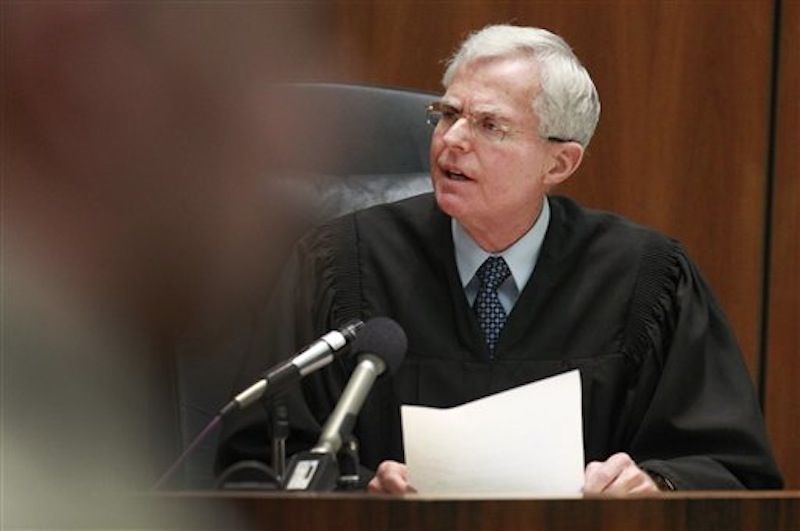LOS ANGELES — There were no witnesses, no fingerprints, no gun and little forensic evidence when a woman was found slain 26 years ago. But there was a human bite mark on her arm — a bite that came back to haunt a female police detective who was unmasked as the killer of her former lover’s wife.
Stephanie Lazarus, trained in police procedures, knew enough to cover her tracks, prosecutors said, but could not have guessed in 1986 that the bite would be analyzed by a tool known as DNA testing, which was in its infancy then.
The advances of DNA analysis were underlined by the presence in court Thursday of Superior Court Judge Lance Ito who presided over the first famous DNA case in the Los Angeles courts, the 1995 O.J. Simpson murder trial which ended in acquittal. Ito, whose court is down the hall from that of Superior Court Judge Robert Perry, had occasionally stopped in to listen to DNA testimony during the Lazarus trial.
Lazarus faces a sentence of 25 years to life after a jury found her guilty Thursday of the murder of Sherri Rasmussen, a 29-year-old nursing supervisor who had married the man that Lazarus loved.
Lazarus, 51, was impassive as she heard the first-degree murder verdict. Her long-ago lover, John Ruetten, now white haired, watched grimly in the courtroom with the family of his slain wife.
“Had it not been for DNA the case might never have been solved,” said District Attorney Steve Cooley who attended the verdict along with a team of officers who worked on the evidence.
It was Lazarus’ own colleagues in the LAPD who resurrected the cold case killing and connected her with a combination of scientific evidence and old fashioned police work. Once they learned that the DNA was from a woman, they eliminated all other possible female suspects and began following Lazarus surreptitiously to collect her DNA.
On a shopping trip, they saw her discard a cup from which she had been drinking. They collected it and the DNA comparison convinced them. They had only to cross the hall and confront her. After a lengthy interview in which she denied guilt, they arrested her and took another DNA sample.
Her sterling police career and her life as she knew it were over.
Police Chief Charlie Beck, who had worked closely with Lazarus in the LAPD, apologized to the Rasmussen family Thursday for the long delay in closing the case.
Detectives initially believed two robbers who had attacked another woman in the area were to blame.
“I am truly sorry for the loss of your wife, of your daughter. I am also sorry it took us so long to solve this case and bring a measure of justice to this tragedy,” he said in a written statement.
“This case was a tragedy on every level,” he added. “The LAPD family felt a sense of betrayal to have an officer commit such a terrible crime.”
The police officer’s union issued a statement saying it hoped the case would not tarnish the reputation of thousands of dedicated police officers.
Lazarus went on to marry another policeman and adopt a daughter. She rose in the ranks, becoming a detective in charge of art forgeries and thefts. Lazarus’ mother, her siblings and her husband also were present.
“I’m just devastated,” said Steven Lazarus, her brother who attended every day of the trial. “It’s been a difficult thing for our whole family. I have very strong feelings about how the trial played out. It is very sad.”
The conviction came after a three-week trial that included testimony from a forensic expert who said the DNA found in the bite mark was a match to Lazarus.
Her defense attorney, Mark Overland, countered that the DNA was packaged improperly and deteriorated while stored in a coroner’s freezer for two decades. He also suggested there might have been evidence tampering.
Prosecutors Shannon Presby and Paul Nunez suggested that Lazarus, consumed by jealousy over Ruetten’s recent marriage went to the condo he shared with his new wife and confronted her. Presby said in closing arguments it was impossible to know whether Lazarus planned to kill her or whether a fight escalated into uncontrollable violence. Rasmussen was bludgeoned about the head and shot three times in her chest.
They suggested that Lazarus knew to avoid leaving other evidence such as fingerprints and may have worn gloves. But she may not have thought of the bite mark, they said.
The family of Rasmussen cried softly after the verdict was delivered in the courtroom ringed by 10 sheriff’s deputies.
“The family is relieved that this 26-year nightmare has concluded with the positive identification of the person who killed their daughter,” said John Taylor, an attorney for the Rasmussen family. “And they now know what the intent was.”
Lazarus’ sentencing was set for May 4. She faces 25 years to life in prison with the possibility of parole plus two years for a gun enhancement.
Luis Patino, a spokesman for the California Board of Prison Terms, said Lazarus would be eligible for parole consideration after serving 16 years and 8 months. She has been in jail since 2009.
Her lawyer said there will be an appeal. The jury spent little more than a day deliberating and he said, “The speed shows we never had a chance.”
The Rasmussen family has filed a wrongful death lawsuit against the LAPD and the city of Los Angeles.
Send questions/comments to the editors.



